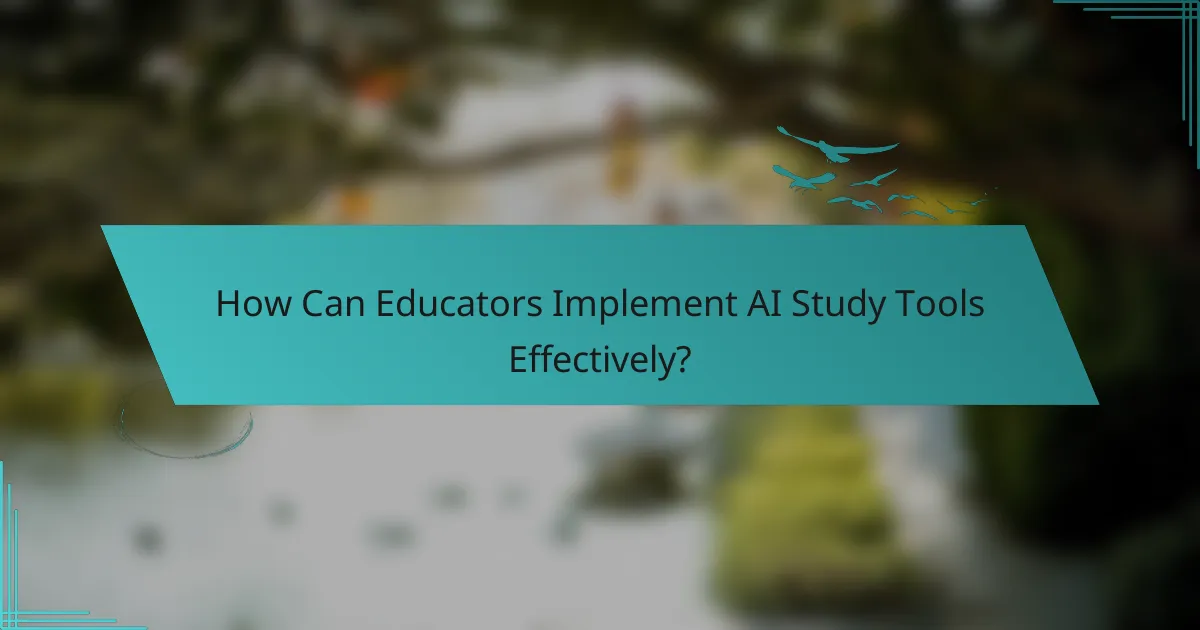AI study tools designed for performance tracking empower educators to effectively monitor student progress and address learning gaps. By utilizing data analytics, these tools offer valuable insights that enable personalized instruction and support tailored to individual student needs. With features like real-time feedback and user-friendly interfaces, educators can enhance their teaching strategies and improve overall student outcomes.
![]()
What Are the Best AI Study Tools for Performance Tracking?
The best AI study tools for performance tracking help educators monitor student progress, identify learning gaps, and tailor instruction accordingly. These tools leverage data analytics to provide insights into student performance, making it easier for teachers to support individual learning needs.
Google Classroom
Google Classroom offers a user-friendly platform for performance tracking through its integration with Google Drive and other Google services. Educators can assign tasks, collect submissions, and provide feedback all in one place, allowing for streamlined performance monitoring.
Key features include grade tracking, assignment analytics, and the ability to track student engagement. Teachers can easily see which students are excelling and which may need additional support, making it a practical choice for many classrooms.
Edmodo
Edmodo is designed as a social learning platform that includes performance tracking features. It allows educators to create assignments, quizzes, and polls while tracking student progress through a comprehensive dashboard.
With Edmodo, teachers can analyze student performance over time and adjust their teaching strategies accordingly. The platform also supports communication between teachers, students, and parents, enhancing the overall learning experience.
Classcraft
Classcraft gamifies the learning experience while providing robust performance tracking tools. Educators can monitor student progress through quests and challenges, which can be tailored to meet specific learning objectives.
This tool encourages student engagement and motivation, as students earn rewards for completing tasks. Teachers can track individual and group performance, making it easier to identify areas for improvement.
Gradescope
Gradescope focuses on streamlining the grading process while offering insights into student performance. It supports various types of assessments, including exams, homework, and projects, allowing educators to analyze results efficiently.
With Gradescope, teachers can identify trends in student performance and adjust their teaching methods based on data-driven insights. The platform also facilitates collaborative grading, which can enhance consistency and fairness in assessments.
Canvas
Canvas is a comprehensive learning management system that includes powerful performance tracking features. Educators can create assignments, quizzes, and discussions while monitoring student engagement and progress through detailed analytics.
Canvas provides customizable reports that help teachers identify at-risk students and tailor interventions. Its integration with various educational tools enhances its functionality, making it a versatile option for educators looking to improve student outcomes.
![]()
How Do AI Study Tools Enhance Educator Performance Tracking?
AI study tools significantly improve educator performance tracking by automating various assessment processes, providing real-time insights, and delivering personalized feedback. These features help educators efficiently monitor student progress and adapt their teaching strategies accordingly.
Automated grading
Automated grading allows educators to quickly assess student work, reducing the time spent on manual evaluations. AI systems can grade multiple-choice tests, essays, and even coding assignments, often providing results in a matter of seconds.
While automated grading increases efficiency, it’s essential to ensure that the AI system is calibrated correctly to maintain accuracy. Educators should regularly review the grading criteria and adjust them based on student performance to avoid potential biases.
Real-time analytics
Real-time analytics provide educators with immediate insights into student performance, enabling them to identify trends and areas needing improvement. These tools can track metrics such as engagement levels, assignment completion rates, and test scores.
By leveraging real-time data, educators can make informed decisions about instructional strategies and interventions. For example, if a significant number of students struggle with a particular topic, educators can adjust their lesson plans to address those gaps promptly.
Personalized feedback
Personalized feedback is crucial for student development, and AI tools can generate tailored comments based on individual performance. This feedback can highlight strengths and areas for improvement, guiding students on their learning journey.
To maximize the effectiveness of personalized feedback, educators should encourage students to engage with the comments and set specific goals for improvement. Regular check-ins can help ensure that students are applying the feedback and making progress toward their learning objectives.

What Features Should Educators Look for in AI Study Tools?
Educators should prioritize features that enhance performance tracking and facilitate effective learning. Key functionalities include integration capabilities, user-friendly interfaces, and robust data visualization tools.
Integration capabilities
Integration capabilities allow AI study tools to connect seamlessly with existing educational platforms, such as Learning Management Systems (LMS) and grade books. This ensures that data flows smoothly between systems, reducing the need for manual data entry and minimizing errors.
When evaluating tools, consider whether they support popular platforms like Google Classroom or Canvas. A tool that integrates well can save educators time and enhance the overall learning experience by providing a unified view of student progress.
User-friendly interface
A user-friendly interface is essential for both educators and students to navigate the AI study tool effectively. Look for intuitive designs that require minimal training, allowing users to focus on learning rather than figuring out how to use the software.
Features like customizable dashboards, easy access to performance metrics, and straightforward navigation can significantly enhance usability. Tools that prioritize user experience tend to see higher engagement and satisfaction rates among students.
Data visualization tools
Data visualization tools help educators interpret student performance data quickly and effectively. Look for features that present information in clear graphs, charts, and dashboards, making it easier to identify trends and areas needing attention.
Effective data visualization can include heat maps showing student engagement levels or progress tracking graphs. These visual aids allow educators to make informed decisions about instructional strategies and interventions, ultimately improving student outcomes.

How Can Educators Implement AI Study Tools Effectively?
Educators can implement AI study tools effectively by focusing on training, piloting, and gathering feedback. These steps ensure that both staff and students are equipped to utilize these technologies to enhance learning outcomes.
Training sessions for staff
Training sessions are essential for educators to understand how to use AI study tools effectively. These sessions should cover the features of the tools, data privacy considerations, and best practices for integrating AI into the curriculum.
Consider organizing workshops that allow staff to engage with the tools hands-on. This practical experience can help them feel more confident in using AI technologies in their teaching methods.
Pilot programs
Pilot programs allow educators to test AI study tools in a controlled environment before full implementation. Selecting a small group of classes or subjects can provide valuable insights into the effectiveness and challenges of the tools.
During the pilot, monitor key performance indicators such as student engagement and academic performance. This data will help in making informed decisions about scaling the use of AI tools across the institution.
Feedback loops with students
Establishing feedback loops with students is crucial for understanding their experiences with AI study tools. Regular surveys or focus groups can provide insights into what works well and what needs improvement.
Encourage students to share their thoughts on usability, engagement, and learning outcomes. This feedback can guide educators in adjusting their approach and enhancing the effectiveness of AI tools in the learning environment.

What Are the Costs Associated with AI Study Tools?
The costs associated with AI study tools can vary significantly based on the pricing model, features offered, and the specific needs of educators. Understanding these costs is essential for making informed decisions about which tools to implement in educational settings.
Subscription models
Subscription models for AI study tools typically involve monthly or annual fees, which can range from a few dollars to several hundred dollars per user, depending on the features included. These models often provide ongoing updates and support, making them appealing for educators who want access to the latest technology without a large upfront investment.
When considering subscription options, it’s important to evaluate the number of users and the specific functionalities needed. Some platforms offer tiered pricing based on the size of the institution or the level of service required, which can help in budgeting effectively.
One-time purchase options
One-time purchase options allow educators to buy AI study tools outright, often resulting in a higher initial cost but no recurring fees. Prices for these tools can vary widely, typically ranging from a few hundred to several thousand dollars, depending on the complexity and capabilities of the software.
While one-time purchases can be cost-effective in the long run, they may lack the continuous updates and support that subscription models provide. Educators should weigh the benefits of immediate ownership against the potential need for future upgrades or technical assistance.
Cost-benefit analysis
Conducting a cost-benefit analysis is crucial when evaluating AI study tools. This involves comparing the total costs of ownership, including initial purchase or subscription fees, against the expected benefits such as improved student performance and time savings for educators.
Consider factors like user engagement, ease of integration into existing curricula, and the potential for enhanced learning outcomes. A thorough analysis can help determine whether the investment in AI study tools is justified based on the specific educational goals and budget constraints of the institution.